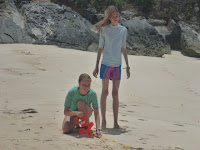"This week has been an awesome, fun, and exciting experience. Today was an extremely eventful day; we had a great dive. This was one of the best dives yet. We are definitely looking forward to doing the night dive tonight. It will be one of the five mandatory specialty dives for our Advanced Certification. We’ve already done the Boat Dive, the Deep Dive, and the Naturalist Dive (which was done today). All that is left is the Navigation Dive and the Night Dive which should be an amazing experience tonight. As well as doing our Night Dive tonight at Whale Bone Bay, we will be having a cozy bonfire with delicious S'mores. We are all so very excited!
During the dive at the Rita Zavetto today, we did a fish ID survey. This survey consisted of identifying the species of fish and the density of that species in the area. We saw a countless amount of fish including: French Grunts, many Foureye Butterfly, Spanish Hogfish, several kinds Parrot fish, many Blue Tangs, abundant amounts of Blueheads, and a school of Bermuda Chub. We also saw came across some interesting organisms like the squid that followed Nathaniel and I, some aggressive Sergeant Majors that were protecting their eggs, the docile Puddingwife that was letting us touch him (I came face to face with him for a few moments before I got freaked out), and the cautious Honeycomb Cowfish. I also really hope to see some nocturnal marine life during tonight’s night dive.
Towards the end of the day, we watched an excellent movie on plastic. It discussed the nightmarish, yet real, environmental issues relating to synthetic plastic including the North Atlantic gyre which is holding hundreds of tons of plastics. This is a significant problem because aquatic animals are eating plastic. As you may know, plastic contains many harmful chemicals which are absorbed into the bodies of aquatic life when they are broken down. These chemicals are transferred up the food chain, finally ending up in our food. We played a part in this by trailing a floating net behind the boat and collecting any plastics that may have been floating on the surface of the ocean. The information we collected was uploaded into a global database to provide enough evidence to eventually create a lawsuit and stop this worldwide problem."




















































